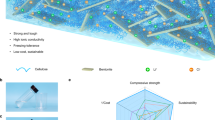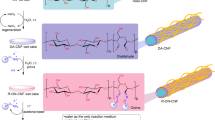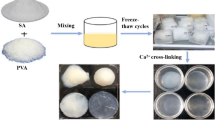Abstract
As a class of typical supramolecular dynamic interactions, metal–ligand coordination has been widely used to fabricate high-performance hydrogels and coordination polymers (CPs). However, the synchronous achievement of functionalizing coordination hydrogels and shaping a stable CP through an in situ growing process in aqueous systems is still a challenge. In this paper, a series of polyacrylamide/polyanionic cellulose/Zr–CP (PAM/PAC/Zr–CP) composite hydrogels were prepared via acrylamide polymerization in aqueous solutions of PAC and disodium terephthalate (Na2BDC), followed by posttreatment in 0.1 M ZrOCl2 solution. The coordination of Zr(IV) clusters with carboxylates on PAC and BDC2− endows the hydrogels with improved strength and adsorption of methyl orange (MO). Increasing the PAC and/or Na2BDC amount in the precursor solution lowers the swelling ratio, tightens the network, and elevates the mechanical and MO-adsorptive properties of composite hydrogels, and the PAC dosage generates a more significant influence than the Na2BDC concentration owing to the greater contribution of PAC to the network structures and Zr–CP states than that of BDC2−. Specifically, over 5 MPa of compressive strength and 500 mg MO/g Zr of MO-adsorption capacity are attained. In brief, this work provides a facile and green approach to synthesize CP-based composite hydrogels with enhanced mechanical and adsorptive properties through strong metal–ligand coordination.
This is a preview of subscription content, access via your institution
Access options
Subscribe to this journal
Receive 12 print issues and online access
$259.00 per year
only $21.58 per issue
Buy this article
- Purchase on Springer Link
- Instant access to full article PDF
Prices may be subject to local taxes which are calculated during checkout






Similar content being viewed by others
References
Khare E, Holten-Andersen N, Buehler MJ. Transition-metal coordinate bonds for bioinspired macromolecules with tunable mechanical properties. Nat Rev Mater 2021;6:421–36. https://doi.org/10.1038/s41578-020-00270-z.
Li C, Wang C, Keplinger C, Zuo J, Jin L, Sun Y, et al. A highly stretchable autonomous self-healing elastomer. Nat Chem 2016;8:618–24. https://doi.org/10.1038/nchem.2492.
Sun W, Xue B, Fan Q, Tao R, Wang C, Wang X, et al. Molecular engineering of metal coordination interactions for strong, tough, and fast-recovery hydrogels. Sci Adv 2020;6:eaaz9531. https://doi.org/10.1126/sciadv.aaz9531.
Shi L, Ding P, Wang Y, Zhang Y, Ossipov D, Hilborn J. Self-healing polymeric hydrogel formed by metal-ligand coordination assembly: design, fabrication, and biomedical applications. Macromol Rapid Commun 2019;40:e1800837. https://doi.org/10.1002/marc.201800837.
Wei Z, He J, Liang T, Oh H, Athas J, Tong Z, et al. Autonomous self-healing of poly(acrylic acid) hydrogels induced by the migration of ferric ions. Polym Chem 2013;4:4601–5. https://doi.org/10.1039/c3py00692a.
Zheng SY, Ding H, Qian J, Yin J, Wu ZL, Song Y, et al. Metal-coordination complexes mediated physical hydrogels with high toughness, stick–slip tearing behavior, and good processability. Macromolecules 2016;49:9637–46. https://doi.org/10.1021/acs.macromol.6b02150.
Sun J, Zhao X, Illeperuma WRK, Chaudhuri O, Oh KH, Mooney DJ, et al. Highly stretchable and tough hydrogels. Nature 2012;489:133–6. https://doi.org/10.1038/nature11409.
Yang CH, Wang MX, Haider H, Yang JH, Sun J, Chen YM, et al. Strengthening alginate/polyacrylamide hydrogels using various multivalent cations. Acs Appl Mater Inter 2013;5:10418–22. https://doi.org/10.1021/am403966x.
Hua D, Gao S, Zhang M, Ma W, Huang C. A novel xanthan gum-based conductive hydrogel with excellent mechanical, biocompatible, and self-healing performances. Carbohyd Polym 2020;247:116743. https://doi.org/10.1016/j.carbpol.2020.116743.
Liang D, Zhou G, Hu Y, Zhao C, Chen C. Metal cation-ligand interaction modulated mono-network ionic conductive hydrogel for wearable strain sensor. J Mater Sci 2021;56:14531–41. https://doi.org/10.1007/s10853-021-06242-0.
Liu Y, Lu N, Liu F, Na R, Wang G, Guan S, et al. Highly strong and tough double-crosslinked hydrogel electrolyte for flexible supercapacitors. ChemElectroChem 2020;7:1007–15. https://doi.org/10.1002/celc.201902134.
Shin S, Lee W, Kim S, Lee M, Koo JM, Hwang SY, et al. Ion-conductive self-healing hydrogels based on an interpenetrating polymer network for a multimodal sensor. Chem Eng J 2019;371:452–60. https://doi.org/10.1016/j.cej.2019.04.077.
Wang T, Ren X, Bai Y, Liu L, Wu G. Adhesive and tough hydrogels promoted by quaternary chitosan for strain sensor. Carbohyd Polym 2021;254:117298. https://doi.org/10.1016/j.carbpol.2020.117298.
Wang J, Wang X, Wang Y, Hu X, Lian J, Guan Y, et al. Room-temperature preparation of coordination polymers for biomedicine. Coord Chem Rev 2020;411:213256. https://doi.org/10.1016/j.ccr.2020.213256.
Liu Y, Lv S, Liu D, Song F. Recent development of amorphous metal coordination polymers for cancer therapy. Acta Biomater 2020;116:16–31. https://doi.org/10.1016/j.actbio.2020.09.019.
Liu X, Xie L, Wu Y. Recent advances in the shaping of metal–organic frameworks. Inorg Chem Front 2020;7:2840–66. https://doi.org/10.1039/c9qi01564g.
Garai A, Shepherd W, Huo J, Bradshaw D. Biomineral-inspired growth of metal–organic frameworks in gelatin hydrogel matrices. J Mater Chem B 2013;1:3678–84. https://doi.org/10.1039/c3tb20814a.
Maan O, Song P, Chen N, Lu Q. An in situ procedure for the preparation of zeolitic imidazolate framework-8 polyacrylamide hydrogel for adsorption of aqueous pollutants. Adv Mater Interfaces 2019;6:1801895. https://doi.org/10.1002/admi.201801895.
Zhu H, Zhang Q, Zhu S. Alginate hydrogel: A shapeable and versatile platform for in situ preparation of metal–organic framework-polymer composites. Acs Appl Mater Inter 2016;8:17395–401. https://doi.org/10.1021/acsami.6b04505.
Klein SE, Sosa JD, Castonguay AC, Flores WI, Zarzar LD, Liu Y. Green synthesis of Zr-based metal–organic framework hydrogel composites and their enhanced adsorptive properties. Inorg Chem Front 2020;7:4813–21. https://doi.org/10.1039/d0qi00840k.
Lim J, Lee EJ, Choi JS, Jeong NC. Diffusion control in the in situ synthesis of iconic metal–organic frameworks within an ionic polymer matrix. Acs Appl Mater Inter 2018;10:3793–800. https://doi.org/10.1021/acsami.7b17662.
Liu W, Erol O, Gracias DH. 3D printing of an in situ grown MOF hydrogel with tunable mechanical properties. Acs Appl Mater Inter 2020;12:33267–75. https://doi.org/10.1021/acsami.0c08880.
Alvarez JR, Sánchez-González E, Pérez E, Schneider-Revueltas E, Martínez A, Tejeda-Cruz A, et al. Structure stability of HKUST-1 towards water and ethanol and their effect on its CO2 capture properties. Dalton Trans 2017;46:9192–200. https://doi.org/10.1039/c7dt01845b.
Li N, Chen G, Chen W, Huang J, Tian J, Wan X, et al. Multivalent cations-triggered rapid shape memory sodium carboxymethyl cellulose/polyacrylamide hydrogels with tunable mechanical strength. Carbohyd Polym 2017;178:159–65. https://doi.org/10.1016/j.carbpol.2017.09.030.
Yang J, Xu F, Han C. Metal ion mediated cellulose nanofibrils transient network in covalently cross-linked hydrogels: mechanistic insight into morphology and dynamics. Biomacromolecules 2017;18:1019–28. https://doi.org/10.1021/acs.biomac.6b01915.
Niu J, Wang J, Dai X, Shao Z, Huang X. Dual physically crosslinked healable polyacrylamide/cellulose nanofibers nanocomposite hydrogels with excellent mechanical properties. Carbohyd Polym 2018;193:73–81. https://doi.org/10.1016/j.carbpol.2018.03.086.
Wang J, Ma Y, Dai X, Gong B, Chen P, Shao Z, et al. Stiffened and toughened polyacrylamide/polyanionic cellulose physical hydrogels mediated by ferric ions. Colloid Polym Sci 2021;299:999–1009. https://doi.org/10.1007/s00396-021-04823-8.
Dai X, Wang J, Teng F, Shao Z, Huang X. Zr(IV)-crosslinked polyacrylamide/polyanionic cellulose composite hydrogels with high strength and unique acid resistance. J Polym Sci Pol Phys 2019;57:981–91. https://doi.org/10.1002/polb.24853.
Bai Y, Dou Y, Xie L, Rutledge W, Li J, Zhou H. Zr-based metal–organic frameworks: design, synthesis, structure, and applications. Chem Soc Rev 2016;45:2327–67. https://doi.org/10.1039/c5cs00837a.
Jiang Y, Liu S, Yuan Q, Liang H. Zr-based acid-stable nucleotide coordination polymers: An excellent platform for acidophilic enzymes immobilization. J Inorg Biochem 2021;216:111338. https://doi.org/10.1016/j.jinorgbio.2020.111338.
Fu J, Wu Y. A showcase of green chemistry: Sustainable synthetic approach of zirconium-based MOF materials. Chem Eur J 2021;27:9967–87. https://doi.org/10.1002/chem.202005151.
Liang C, Ren J, El Hankari S, Huo J. Aqueous synthesis of a mesoporous Zr-based coordination polymer for removal of organic dyes. ACS Omega 2020;5:603–9. https://doi.org/10.1021/acsomega.9b03192.
Voronova MI, Surov OV, Afineevskii AV, Zakharov AG. Properties of polyacrylamide composites reinforced by cellulose nanocrystals. Heliyon 2020;6:e05529. https://doi.org/10.1016/j.heliyon.2020.e05529.
El-Sayed S, Mahmoud KH, Fatah AA, Hassen A. DSC, TGA and dielectric properties of carboxymethyl cellulose/polyvinyl alcohol blends. Phys B 2011;406:4068–76. https://doi.org/10.1016/j.physb.2011.07.050.
Mali KK, Dhawale SC, Dias RJ, Dhane N, Ghorpade V. Citric acid crosslinked carboxymethyl cellulose-based composite hydrogel films for drug delivery. Indian J Pharm Sci 2018;80:657–67. https://doi.org/10.4172/pharmaceutical-sciences.1000405.
Lee DW, Didriksen T, Olsbye U, Blom R, Grande CA. Shaping of metal-organic framework UiO-66 using alginates: Effect of operation variables. Sep Purif Technol 2020;235:116182. https://doi.org/10.1016/j.seppur.2019.116182.
Burrows HD, Ellis HA, Utah SI. Adsorbed metal ions as stabilizers for the thermal degradation of polyacrylamide. Polymer 1981;22:1740–44. https://doi.org/10.1016/0032-3861(81)90397-9.
Yang J, Ying R, Han C, Hu Q, Xu H, Li J, et al. Adsorptive removal of organic dyes from aqueous solution by a Zr-based metal–organic framework: effects of Ce(III) doping. Dalton Trans 2018;47:3913–20. https://doi.org/10.1039/c8dt00217g.
Molavi H, Hakimian A, Shojaei A, Raeiszadeh M. Selective dye adsorption by highly water stable metal-organic framework: Long term stability analysis in aqueous media. Appl Surf Sci 2018;445:424–36. https://doi.org/10.1016/j.apsusc.2018.03.189.
Simonin J. On the comparison of pseudo-first order and pseudo-second order rate laws in the modeling of adsorption kinetics. Chem Eng J 2016;300:254–63. https://doi.org/10.1016/j.cej.2016.04.079.
Revellame ED, Fortela DL, Sharp W, Hernandez R, Zappi ME. Adsorption kinetic modeling using pseudo-first order and pseudo-second order rate laws: A review. Clean Eng Tech 2020;1:100032. https://doi.org/10.1016/j.clet.2020.100032.
Wang J, Guo X. Adsorption kinetic models: Physical meanings, applications, and solving methods. J Hazard Mater 2020;390:122156. https://doi.org/10.1016/j.jhazmat.2020.122156.
Acknowledgements
This study was financially supported by the Fundamental Research Funds for the Central Universities (2021CX02043).
Author information
Authors and Affiliations
Corresponding author
Ethics declarations
Conflict of interest
The authors declare no competing interests.
Additional information
Publisher’s note Springer Nature remains neutral with regard to jurisdictional claims in published maps and institutional affiliations.
Supplementary information
Rights and permissions
About this article
Cite this article
Zheng, C., Wang, J., Jiang, H. et al. Green synthesis of polyacrylamide/polyanionic cellulose hydrogels composited with Zr-based coordination polymer and their enhanced mechanical and adsorptive properties. Polym J 54, 515–524 (2022). https://doi.org/10.1038/s41428-021-00590-z
Received:
Revised:
Accepted:
Published:
Issue Date:
DOI: https://doi.org/10.1038/s41428-021-00590-z
This article is cited by
-
Special issue: Fundamentals and applications of carbohydrate polymers
Polymer Journal (2022)



